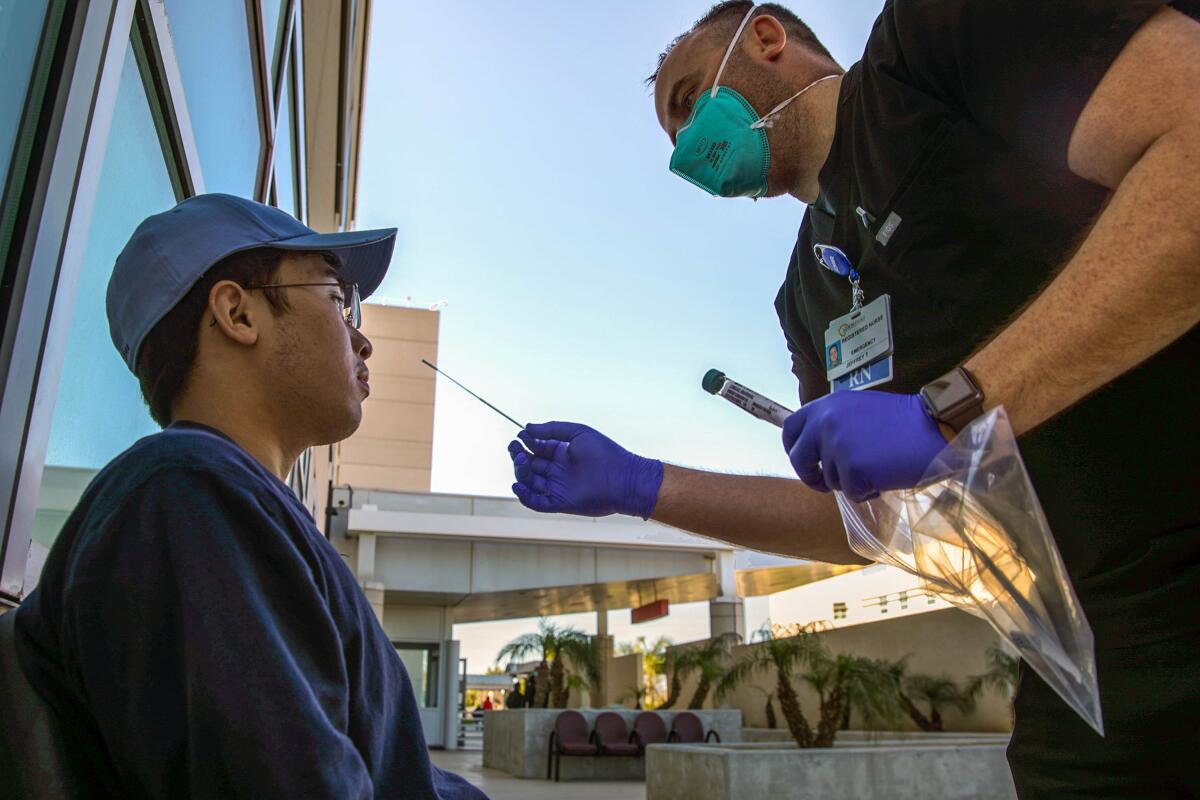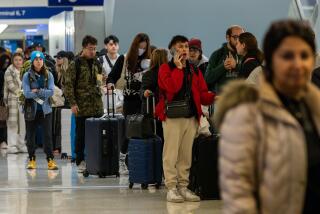L.A. County logs nearly tenfold increase in coronavirus cases in a month

Los Angeles County on Monday reported more than 31,500 new coronavirus cases â marking a nearly tenfold increase from the number of new cases tallied a month ago and offering a stark reminder of the lasting power of the highly contagious Omicron variant.
Officials announced 31,576 new cases Monday, as well as 27 related deaths, compared with 3,360 new cases reported on Dec. 17. Mondayâs figures, officials cautioned, might be undercounts because of reporting delays over the weekend and holiday.
âOn this national holiday where we celebrate the life and legacy of Dr. Martin Luther King, we remember his deep commitment to health equity,â said L.A. County Public Health Director Barbara Ferrer. âAs Reverend King memorably said, âOf all the forms of inequality, injustice in health is the most shocking and the most inhuman because it often results in physical death.ââ
And that tragic reality, Ferrer said, has played out again and again throughout the pandemic.
In L.A. County, as in most every corner of the nation, Black and Latino people have been hospitalized and died at disproportionately high rates of complications of COVID-19 â a disparity, Ferrer said, that points to âthe impact of racism, historical disinvestment and social marginalization.â
âWhile these conditions predate the pandemic, without deliberate collective actions to address the root causes of health inequities,â Ferrer said, âwe are unlikely to close the gaps we have documented for two long years.â
The daily positivity rate in L.A. County now hovers above 16% â up from 2% a month ago â and the number of Angelenos hospitalized with the virus has increased to more than 4,560, up from roughly 770 a month ago.
While daily death figures in the region remain well below the peak from last winter, L.A. County has logged an average of 42 COVID deaths per day, the highest fatality rate in nearly 10 months, and double the prior weekâs death rate. Health experts had initially suspected many of the recent deaths were tied to the earlier Delta variant, noting that, in some cases, patients have been sick and hospitalized for quite some time.
But on Saturday, the L.A. County Department of Public Health said that âthe majority of deaths reported this week are associated with individuals who became infected after Dec. 20, when Omicron was circulating widely,â suggesting that Omicron may end up playing a bigger role in COVID-19 deaths than initially believed.
âSo itâs not that Omicron is completely harmless. It can cause severe disease in some people,â said Dr. Paul Simon, chief science officer for the L.A. County Department of Public Health, in an interview Friday.
Although highly infectious, the now-dominant Omicron variant is less likely to infect the lungs â often a critical factor in a patientâs decline. And South Africa, where scientists were the first to detect Omicron in November, emerged from its surge with comparatively few deaths.
But some health officials have cautioned against assuming the pattern will hold true in the U.S., which has an older population and could experience a deadlier Omicron wave.
âWe have this maybe warped view about how mild, or milder, Omicron is, when it clearly can kill and put a lot of people in the hospital,â Dr. Eric Topol, director of the Scripps Research Translational Institute in La Jolla, said during a recent online discussion.
More than 28,000 county residents have died since the start of the pandemic.
In recent days, healthcare facilities across the nation have again begun to buckle under spiking infection rates.
Infections and deaths are climbing at nursing homes nationwide and federal data show that children younger than 5 â the age bracket still not eligible for COVID shots â are being newly hospitalized with COVID-19 at higher rates than earlier in the pandemic. The current surge of infections has also created staffing crises at California hospitals and others across the nation. At Tufts Medical Center in Boston, for example, 616 staffers called out sick with COVID-19 on a recent day.
Last week, some local hospitals temporarily postponed scheduled surgeries that require an inpatient stay following an operation, and the trauma center at Harbor-UCLA Medical Center closed for hours because of a blood shortage â a step it hadnât taken in over three decades. A staff shortage at some local ambulance companies further complicated the situation.
Health experts across California â where 68% of people are fully vaccinated â continue to urge anyone who is eligible and hasnât yet been vaccinated or boosted to do so as soon as possible. Experts say that despite some breakthrough cases, largely fueled by Omicron, vaccination still offers strong protection against severe illness.
The virus has spread so fast since the arrival of the Omicron variant that it could take just about a week for California to tally a million new cases. It was only on Jan. 10 that California surpassed 6 million total reported coronavirus cases in the nearly two years since the start of the pandemic, according to data released by state health officials. Even during last winterâs surge, it took three weeks to accumulate a million new cases, with the state peaking at 46,000 new infections a day.
More to Read
Sign up for Essential California
The most important California stories and recommendations in your inbox every morning.
You may occasionally receive promotional content from the Los Angeles Times.











